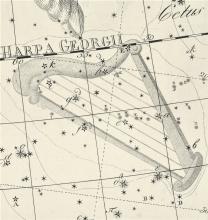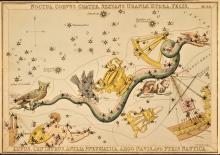Listen to today's episode of StarDate on the web the same day it airs in high-quality streaming audio without any extra ads or announcements. Choose a $8 one-month pass, or listen every day for a year for just $30.
You are here
Vulpecula
A fox carries a goose high across the sky this evening. You need dark skies to pick them out, and a vivid imagination to “see” them.
The constellation Vulpecula stands high in the southeast at nightfall. It’s near the middle of the Summer Triangle, which is defined by the stars Vega, Deneb, and Altair.
Johannes Hevelius created the constellation more than three centuries ago. His original name for it was Vulpecula cum Anser — fox with goose. He showed it as a fox holding a goose in its jaws.
Perhaps the fox later ate the goose, or perhaps the goose escaped and flew away. Whatever the reason, the name was shortened to just Vulpecula — the fox. The goose is still remembered, though, in the name of the constellation’s brightest star — Anser. It’s not much to look at. In fact, you need dark skies to see the star at all.
The star itself is actually pretty impressive. It’s a red giant — a dying star that’s puffed up like a giant balloon. But its distance of 300 light-years dulls its luster.
One of Vulpecula’s claims to fame is the first pulsar. When it was discovered more than a half-century ago, there was a brief hope that it might be a signal from another civilization. But follow-up work showed that it was the crushed, rapidly spinning core of a dead star — an impressive discovery in its own right.
Another dying star has created another impressive object in Vulpecula: the Dumbbell Nebula. We’ll have more about that tomorrow.
Script by Damond Benningfield






